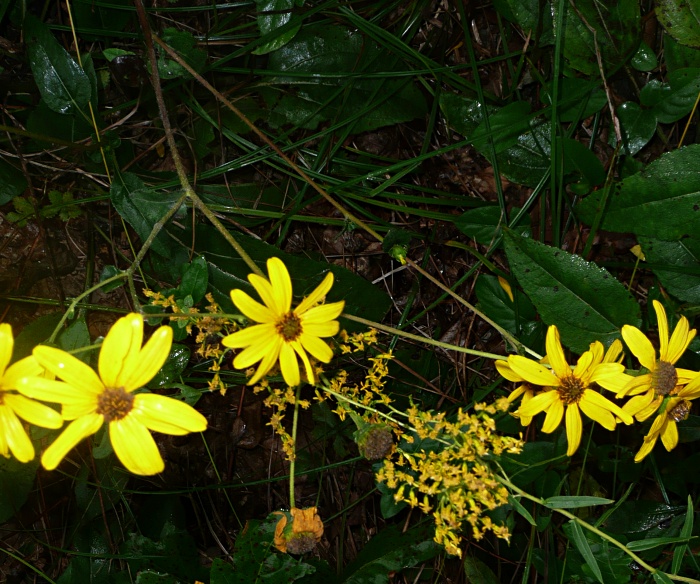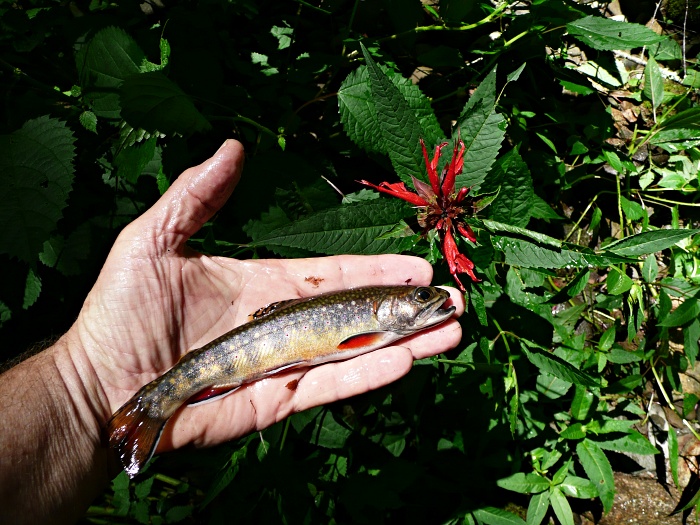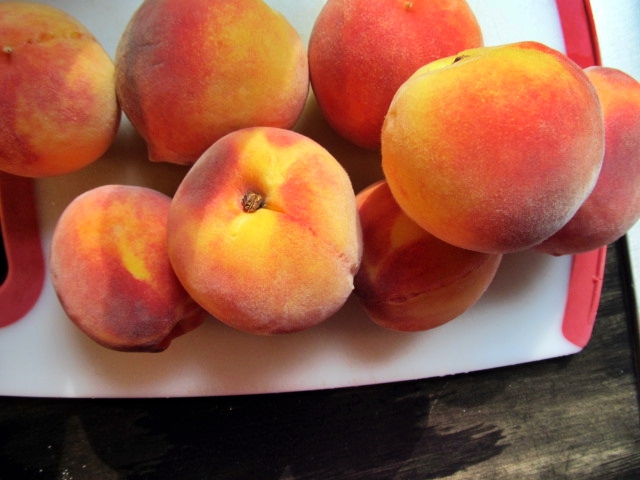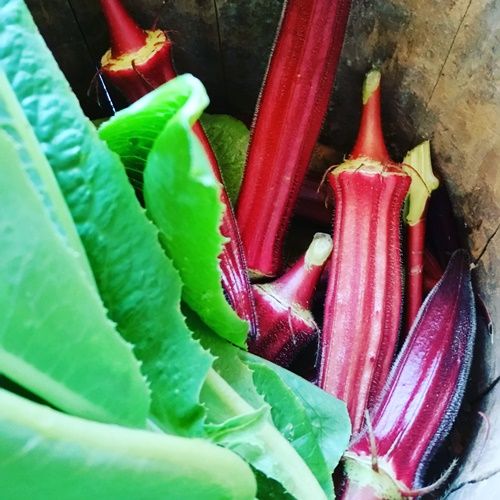AUGUST—A MONTH OF ANXIETY AND ANTICIPATION

Stifling heat, high humidity, weeds running rampant in the garden, indifferent fishing, and general misery seem to typify August in this part of the world. It’s a month to give a man (or woman) the mollygrubs, and it comes second only to February on the list of those I like least. Sometimes, perhaps when I go out to get the morning newspaper and it’s already downright uncomfortable, I’m not at all sure it’s not worse than February. Yet both of these low-ranking months enjoy one positive aspect in common. What lies on the not too distant horizon is pure bliss—the glories of October in one case and the wonders of spring in April and May in the other.
There are, to be sure, a few bright sides to August. At some point in the next 30 to 45 minutes I’ll take a break from the computer where I’m writing this newsletter and fix some lunch. I haven’t given the menu much thought but I do know it will include two delights of the season—vine-ripe tomatoes and slices of a cantaloupe absolutely oozing sweet goodness. The goodness of home-grown tomatoes, with their rich, piquant taste, so far surpasses the cardboard texture and taste pretenders from grocery store shelves that the difference defies description. Similarly, in the case of a cantaloupe from one’s garden, stuff from grocery store shelves pales by comparison. That is at least in part because you can always tell when the melon is ready to harvest. It will slip from the yellowing stem with ease.
Then too, August may mean misery in terms of being out and about, but my does it bring additional bonanzas on the food front–corn on the cob from later plantings, okra, cukes, crowder peas, and eggplant (I like it grilled and topped off for the last minute on the grill pan with Parmesan cheese). With such fixin’s a body doesn’t need meat, and the summer meals of my boyhood were often meatless ones. Cornbread (perhaps cooked with cracklin’s) and green beans or leather britches (dried green beans) cooked with streaked meat were often about as close to meat as we came. Yet there would be an array of six or eight vegetables, home-churned butter to decorate one’s cornbread, and an impressive choice of pickles and relishes on the side. These would include things like pickled peaches, watermelon rind pickles, bread-and-butter or 14-day pickles, pickled okra, chow-chow, and more. In fact, pickled items loomed sufficiently large that this month’s offerings of recipes (see below) focuses on pickles. It was simple but supremely satisfying fare. Moreover, if one got peckish in mid-afternoon or after supper, there was always the choice of sweet milk or buttermilk accompanied by a big chunk of cornbread.
Nor was the sweet tooth ever neglected. Fruit or berry cobblers were our most common dessert, although this was the season of drying peaches as well. Grandma and Momma both made it an annual practice to put up runs of peach butter and to dry a bushel or two of peaches. The latter, spiced just right and used as filling for fried pies, have to rank as one of my all-time favorites in the dessert sweepstakes. In other words, August wasn’t all bad, and even amidst the nastiest of dog days you knew that cooler weather and hunting season weren’t all that far off.
Fond food memories aside, over the course of my lifetime I think it fair to say that my relationship with the month of August has been of a decidedly mixed nature. As a boy the situation was one of love-hate. I loved the lazy days the month brought, with katydids playing their winsome built-in leg fiddles like there was no tomorrow, with Joe Pye weeds beginning to bloom and attract tiger swallowtails, with catfish biting as if somehow they knew winter’s hard times lay but a few months down the road, and with all of the bounty of a spring and summer’s work in long rows of corn and other parts of the garden gracing the family table.

Similarly, August meant that it was time to start letting our beagles do some rabbit chasing in the cool of night, toughening them up for the coming of cottontail season. The mere thought of hunting also reminded me that squirrel season would open in two months. It was a time when the trout streams, often crowded in late spring and early summer, were pretty much devoid of anglers. A boy like me could set out by shank’s mare, with a hearty lunch in his wicker creel, and at least on week days have every expectation of never seeing another angler. For a lad who loved solitude (and still does) that was pure heaven.

We didn’t hunt doves when I was a boy—there just wasn’t enough suitable habitat for them and they didn’t exist in huntable numbers—but in my geographical circumstances in the present August means the opening day of dove season isn’t too far away, and if you are much of a dreamer at all thoughts readily turn to the month which can make a mighty pitch for being the best of all—October. That means cool mornings or late evenings in a deer stand, squirrels barked on hickory ridges, black walnuts on the ground just waiting someone with the gumption to gather them, and a “feel,” elusive when it comes to capturing it in print yet oh so real, of autumn in the air. Anticipation is a fine thing, and there’s plenty of it to be found in August.
JIM’S DOIN’S
Probably the biggest news on the personal front is that the cookbook I’ve been working on with my good friend (and the webmaster who makes it possible for you to get these monthly newsletters), Tipper Pressley, is rounding into form quite nicely. A complete manuscript is now in the hands of the publisher and we are in the final stages of selecting photos for illustration (there will be black-and-white images as well as a portfolio of 32 color ones) in the book. We haven’t decided on a specific title yet, but it will be something in keeping with the region covered, Southern Appalachia, and the traditional foods and foodways we are endeavoring to celebrate.
Beyond that, I continue to write a weekly column for the newspaper serving the area of the Smokies where I grew up, The Smoky Mountain Times. The column, which carries the general title “Mountain Musings and Memories,” provides me with a grand opportunity to recall and celebrate the place of my raising. I don’t recall exactly when I began the column, but I’m certainly well into the second decade of writing it. The effort takes me, and hopefully readers, on a weekly memory trip back into a time and place where I enjoyed a boyhood peopled by wonderful parents, colorful paternal grandparents who lived close by and with whom I was quite close, and a grand cast of true characters. One of my present efforts involves a book on mountain characters and a number of the chapters in it will be devoted to folks I knew as a boy.
Publications of mine that have appeared since last month’s newsletter include “The Delights of Vegetable Mixes,” Smoky Mountain Living, Aug./Sept., 2022, pp. 18-21, the latest in my ongoing coverage of mountain foods for that publication. The issue also includes “John Parris: Muse of the Mountains,” on pp. 60-68. Parris was a talented chronicler of mountain ways who covered the people and places, traditions and traits, of Western North Carolina in a thrice weekly column that appeared in the Asheville Citizen-Times for a period stretching over more than four decades. The latest number of Sporting Classics, a publication I’ve written for over a period of time approaching Parris’ stint with the newspaper (I think my first article appeared in the magazine in 1982 or 1983), carries two of my contributions. One is my regular book column. This one, on pp. 137-43, is on “America’s Greatest Gun Writers and Their Books.” The other effort is a feature story looking back over a lifetime passion for shotguns, “Shotgun Lust,” Sporting Classics, Guns & Hunting issue, 2022, pp. 61-67.
RECIPES
As promised, the food focus for this month is on pickles, something usually prepared in or around August but enjoyed throughout the year. How I loved to come in from a hot session in the garden or maybe helping Grandpa Joe with some kind of chore and go straight to Grandma Minnie’s refrigerator (in my early years it was an ice box but by the time I reached my teens she no longer had to bother with blocks of ice and trips to the back porch whenever she needed something that was “on ice.)” There would be a big jug of wonderfully chilled mountain water, and I still maintain the water in Swain County is the finest I’ve ever drunk. Once I had quenched my thirst I had a choice of treats—a pickled peach or watermelon rind pickles. Both had a sweet-tart taste that really tickled my culinary fancy.
Other pickles made a pretty much constant appearance come mealtime. The okra pickles were a favorite with Grandpa, and he particularly liked them if Grandma had added enough of the hot peppers he grew to give them some real kick. For my part I preferred bread-and-butter pickles as a side item on my plate or perhaps a heaping tablespoon or two of chowchow atop crowder peas or pintos. Of course we got pickles in other ways as well. They were a vital ingredient in deviled eggs and potato salad (the former mainly a special occasion dish while the latter made frequent appearances on the everyday table). Others in the family liked the taste and the flash of bright color offered by pickled beets, but they weren’t for me. There’s almost nothing in the food line I don’t enjoy, but I’ve never cared a whit for pickled beets.
The recipes below take me directly back to the importance of pickles, and I might also add that some of them will be featured in the Southern Appalachian cookbook mentioned above. After all, pickling has always been an important part of mountain diet and the region’s food preservation traditions.

PICKLED PEACHES
Cold water (enough to cover fruit) with a crushed vitamin C tablet or similar means of preventing discoloration stirred in). I have no idea of how Grandma did this, although possibly she used a pinch of flowers of sulfur, something she utilized for the same purpose when drying apples or peaches.
Two dozen small, peeled peaches (early clingstones, which mountain folks knew as Indian peaches, do
particularly well)
2½ cups sugar
1¼ cups distilled white vinegar
4 teaspoons pickling spice
Tablespoon of whole cloves
Pinch (1/4 teaspoon) salt
Put water with dissolved acidulation agent to avoid discoloration in a large bowl. Place peaches in the water and allow to stand for 10 minutes, stirring a couple of times during this period. Drain well using a colander and then toss with the sugar. Chill in a large covered pot or the bowl used for acidulation covered with wrap for 10 to 12 hours. Add vinegar, spices, salt, and a half cup of water to chilled peaches and bring to a boil. Skim off the foam, reduce heat, and simmer for a few minutes until peaches are tender. Place peaches in sterilized canning jars which have been sitting in hot water, making sure to get one or two whole cloves in each jar. Bring reserved liquid from the peaches to a boil and pour over peaches. Use an ice pick or thin knife to run between the peaches and remove any air bubbles. Close jars with canning lids and screw tops and process for 20 to 25 minutes in a canner before removing and allowing to seal.
WATERMELON RIND PICKLES
While most recipes call for cutting away the outer peeling and removing any red flesh next to the rind, Grandma Minnie left the rind intact as well as a goodly bit of the red melon next to the rind. It was an ideal way to utilize the remnants of the “cannonball” or “rattlesnake” watermelons which were an important part of late summer’s pleasures.
BRINE
4 tablespoons salt
1 quart water
Watermelon rinds
PICKLE SYRUP
8 cups sugar
4 cups vinegar
8 teaspoons whole cloves
12 cinnamon sticks
Pinch of mustard seed (optional)
Cut the watermelon rind into one-inch cubes and allow to soak in the brine overnight. The next morning drain off the liquid, add fresh water, and cook the rinds until tender.
Then prepare the pickle syrup, boiling the mixture and then allow to sit for 15 minutes. Add drained watermelon rind and cook until the cubes become somewhat transparent. Process in sterilized jars. Properly done, this sweet pickle will be crunch, tasty, and appealing to the eye.
CHOWCHOW
A relish which belongs to a bowl of October beans the way redeye gravy partners cured ham, chowchow sometimes goes by the name of piccalilli (although I’ve seldom heard that usage in mountain talk). It offered mountain folks a way of preserving a wide variety of vegetables through what was, in essence, a pickling process. Other than common denominators of cabbage and vinegar, the variations on chowchow contents are almost endless. Here’s a recipe as true to Grandma Minnie’s method as my memory allows.
2 heads cabbage, diced fairly fine
6 large green tomatoes, diced
4 tablespoons pickling salt
4 pods dried red pepper, crushed (amount can vary according to your “heat” preferences)
1 cup water
Place the vegetables in a large stoneware crock and then add the other ingredients. Mix thoroughly and pack tightly, being sure the liquid (brine) rises over the top. Cover with cheese cloth and let set in a warm room until the chow “works.” Store in pint or quart jars.
PICKLED OKRA

Most of the okra we grew either found its way to the family table in expeditious fashion as fried okra or else went into soup mix canned for winter use. I don’t ever recall Momma using it for a dish I later came to love, stewed okra and tomatoes, nor did she prepare pickled okra. On the other hand, Grandma , who did a great deal more pickling in general, annually made at least a couple of runs of okra pickles. There would always be pickled pods on a relish tray alongside pickled cucumbers and beets at large gatherings of the extended family.
4 pounds of okra
4 to 8 pods of hot red pepper (8 pods means a fiery pickle)
4 cloves garlic
1 cup apple cider vinegar or white vinegar (for color emphasis white is best)
1 cup water
½ cup pickling salt
Thoroughly wash the pods and cut the stem away quite close at the base. Pack the whole pods, stem end down, into hot, sterilized pint jars. Add pepper and garlic cloves to each jar. Dissolve salt in vinegar and water and bring to a boil. Pour in each jar until full and seal at once.
PICKLED BEANS
When it came to pickling, other vegetables, notably cucumbers but also beets, okra, and corn, received more attention in most households than green beans. But beans were pickled, either strung and broken just as if they were to be cooked fresh from the garden, but whole beans stacked vertically in a jar when pickled made an eye-catcher on the shelf, at a community gathering, or perhaps for an entry at a county fair.
Peck or half bushel of fresh-picked green beans
Large stoneware crock
¾ cup of salt per gallon of green beans
Corn shucks, outer leafs from cabbage, or grape leafs
Clean, string, and break (or leave whole if you want to take that route) the beans. In a large stew pot cook with water until the beans are beginning to soften. Drain and rinse in colder water, draining three or four times until the beans are cool. Add salt, being sure to mix it thoroughly with the beans, and place in the stoneware crock. Cover with leafs or shucks which have been carefully washed. Top with a plate and weight it down with a brick, old hand iron, or a rock. Cover the top of the crock with cheesecloth and tie the cloth down tight. Allow the beans and brine to work for a week and then remove from the crock. Rinse once, quickly, in cold water, and then bring the beans to a boil in a large pot. Place them in sterilized quart jars straight from a hot water bath and then cover with enough brine to reach the top of the beans before sealing.